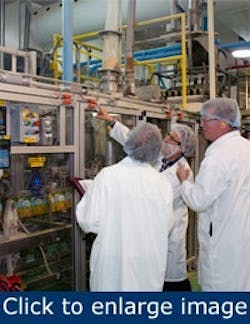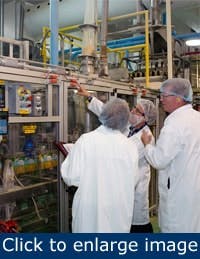Sensors, software and RFID technologies protect workers
The roughly 300 employees at Unilever Canada Lipton in Brampton, Ontario, produce more than 30 million cases of packaged products annually at this highly automated plant. The self-sufficient plant encompasses the entire process from raw materials to mixing, packaging and shipping.
The company wanted to upgrade its facility to achieve its corporate sustainability goals, including a plan to increase machine operator safety, while achieving faster production through reduced downtime. Unilever needed a solution that could pinpoint faults, help prevent overrides and reduce the number of safety relays.
[pullquote]Frustration with downtime inspired an innovative Unilever employee to suggest upgrading the plant’s safety switches. Unilever worked with Rockwell Automation’s authorized distributor Gerrie Electric in Ontario, and its sensor and safety specialist. The specialist offered a sample of the Allen-Bradley SensaGuard RFID non-contact safety switch, which uses inductive technology for sensing, and the RFID technology uses a code that looks for the matching RFID partner block before the machine is allowed to start. The machine can’t be operated if a monitored door is open. The doors are immune to steel or magnets, so they can’t be held open and overridden while the machine runs.
The safety switches are designed and built to global standards rated Category 4/SIL 3 per EN954-1, and TUV functional safety approved to IEC 61508. The rating is maintained even with multiple units connected in series for high reliability and stability. LED indicators located on the switch give a visual indication of door status, indicate door misalignment and offer advanced diagnostics to help identify faults.
This gave Unilever the ability to connect 15 switches to one safety relay that communicates to the main panel. The light indication on the switches provides the information to diagnose any problems.
Unilever Canada installed about 170 safety switches throughout the plant. The technology had standard and safety products working together to turn the safety capital outlay into an investment with positive returns — one that helps to increase employee safety.
The implementation went smoothly and helped to mitigate the challenges the plant had been facing. For example, one of the machines Unilever upgraded was the Knorr Sidekicks Asian production on the Bartelt form, fill and seal machine. Rollers fed the pre-printed airtight foil into the automated machine, where the foil was folded, sealed on three sides, cut into separate pouches, opened, filled and then laser labeled and sealed before it exited the machine onto a conveyor. This process was done within an enclosed plexiglass environment to keep the product sanitary and still allow visibility into the operations. Plexiglass access doors at each station used magnetic safety switches with relays that signaled the entire line to stop when a door was opened. This was designed to protect employees from moving machine parts.
Operators at Unilever examine the status indicator light present on the safety switches, which tells them if the switch is closed or open. If a failure occurs, the unit LED blinks red, alerting operators directly to the problem switch.
The existing hard-contact, safety-interlocking door switches helped keep the employees and machines safe, but if a problem with a switch occurred, it caused downtime, difficult troubleshooting and lost production. The existing magnetic switch system also could be overridden and potentially produce unsafe conditions.
The switch to the SensaGuard safety switches alleviated these issues. The indicator lights on the switches help to minimize production downtime and make troubleshooting easier by pinpointing the faulted sensor and identifying it to the operator. They also help operators to access areas of the machine more safely where there is motion and give them more control to keep the line running as much as possible.
Unilever Canada’s solution met the criteria it was aiming for — to indicate which door is open, identify which switch is faulted and be able to fix problems without the assistance of an electrician, while also reducing the amount of safety relays needed on each application.
The safety switches have helped Unilever to reduce mean time to repair by 3% in 14 months. And because the transmit portion of the switch is coded to match only with its receiver partner, any temptation to bypass the switch cannot be acted upon, which ultimately helps improve employee safety.

